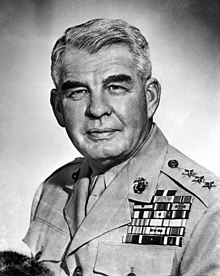Harry Schmidt (USMC)
| Harry Schmidt | |
|---|---|

Lieutenant General Harry Schmidt, USMC
|
|
| Nickname(s) | The Dutchman |
| Born |
September 25, 1886 Holdrege, Nebraska |
| Died | February 10, 1968 (aged 81) |
| Place of burial | Fort Rosecrans National Cemetery, San Diego, California |
| Allegiance |
|
| Service/branch |
|
| Years of service | 1909–1948 |
| Rank |
|
| Commands held |
|
| Battles/wars |
Philippine-American War Mexican Revolution *Battle of Veracruz World War I Banana Wars *United States occupation of Nicaragua Second Sino-Japanese War World War II *Battle of Kwajalein *Battle of Saipan *Battle of Tinian *Battle of Iwo Jima |
| Awards |
Navy Cross Navy Distinguished Service Medal (3) Legion of Merit (Army) Bronze Star Medal |
Harry Schmidt (September 25, 1886 – February 10, 1968) was a United States Marine Corps general. During World War II, he served as the Commanding General of the Fourth Marine Division during the battles of Kwajalein in the Marshall Islands and Saipan in the Mariana Islands, and as Commanding General of the Fifth Amphibious Corps during the battles of Tinian in the Marianas and Iwo Jima in the Volcano Islands.
Schmidt retired from the Marine Corps at age 61 in 1948 with 39 years of service. A contemporary described Schmidt as "a Buddha, a typical old-time Marine: he had been in China; he was regulation Old Establishment; a regular Marine."
Schmidt was born in Holdrege, Nebraska, on 25 September 1886. He attended Nebraska State Normal College for two years before accepting a commission as a second lieutenant in the 2nd Nebraska Infantry which he resigned from on 16 August 1909 in order to enter the U.S. Marine Corps as a second lieutenant on 17 August 1909.
Following instruction at the Marine Officers' School at Port Royal, South Carolina, he reported in January 1911, at the Marine Barracks, Guam, Mariana Islands. While attached to this station, he accompanied an expeditionary force to Chefoo, China. In October 1912, he was ordered to duty in the Philippines where he remained until detached to the United States in April 1913. Following an assignment with the Recruiting Service in Minnesota, a tour of duty at the Marine Barracks, New Orleans, Louisiana, and temporary duty at Veracruz aboard USS Kearsarge (BB-5) in 1915, he was ordered to sea duty aboard USS Oklahoma (BB-37) in May 1916 and was promoted to captain in August. In January 1917, he went aboard the USS Montana (ACR-13) and from 25 February to 22 March 1917, was ashore with the ship's landing force at Guantanamo, Cuba. Leaving the USS Montana in September 1918, he spent most of the next two years at the Marine Barracks, Norfolk, Virginia.
...
Wikipedia
